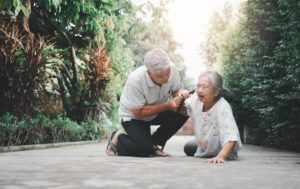What happens when you suffer an injury while walking down the sidewalk in front of a business? You may find yourself with serious injuries that prevent you from working or engaging in the activities you usually love. Worse, you can have medical bills piling up that may make your financial situation even more difficult.
If you suffer injuries due to a sidewalk-related accident, who bears liability, and how can you pursue compensation then contact personal injury lawyer for help?
Who Bears Liability for Sidewalk-Related Injuries?
According to New York City Administrative Code 7-210, businesses must maintain the sidewalks in front of their establishments just like they would maintain their interior. Businesses may bear liability for failure to properly maintain the sidewalk in a way that leads to an accident, including failure to take care of snow, ice, or debris.
Broken Pavement
Broken pavement can pose a serious hazard, especially for people wearing dress shoes or heels, people not paying attention to their feet as they walk, or people in a hurry. In heavy foot traffic, it may prove challenging to avoid broken patches of a sidewalk, even for people exercising all due caution as they make their way through the road.
Business owners need to take care of sidewalk damage outside the store quickly. If they do not take care of that damage promptly, they may bear liability for any injuries caused by that inattention.
Snow and Ice
Across New York, including New York City, snow and ice can pose a serious problem for many people. As the temperatures dip near freezing, icy streets can lead to increased accident risk, both on the roads and for pedestrians.
New York business owners must arrange to have snow and ice cleared away from the sidewalk in front of the business to reduce the risk of a slip-and-fall accident. If business owners do not take care of clearing that snow and ice away, they may bear liability when visitors, workers, or passers-by suffer injuries in a fall due to that icy surface.
Cluttered Sidewalks
Business owners may choose to use their sidewalks to help draw attention to the store itself. They may spread their goods onto the sidewalk, showcasing sales or new merchandise to help entice people into the building. Using the sidewalk can also provide more space for exhibits, especially during busy times of the year.
However, cluttered sidewalks, including sidewalks cluttered by cords or items that have fallen to the ground, can pose a more significant fall hazard for people in that area. Businesses that allow their sidewalks to grow increasingly cluttered may bear liability for any accident caused by that increased clutter.
Fallen Branches, Leaves, and Nut Casings
Trees outside a business can provide shade, a hint of greenery or color, depending on the season, and an inviting aura that encourages people to come in and check out the business or to linger in the area. However, those trees may also pose a hazard, particularly during the fall, when leaves fall throughout the season.
Slippery leaves can pose a slip-and-fall risk, especially for guests wearing slick shoes. Nut casings can quickly slip underfoot, making it hard for people to keep their footing as they hurry by on the sidewalk. Business owners may need to make arrangements to clean those items away regularly, providing better overall footing for people passing by their stores.
In cases where the business owner fails to take care of maintenance or cleanup around the sidewalk, the business owner may bear liability for sidewalk-related injuries. However, other entities may also assume liability: a vendor that spreads cords across the sidewalk without permission from the business owner, for example. If you suffered injuries on a sidewalk due to the negligence of any party, contact an attorney to get a better idea of who may bear liability for your specific accident.
Common Sidewalk Injuries
Sidewalk-related injuries often occur because of a slip or trip and fall. A minor fall may mean the victim walks away with little more than bruised dignity. A more severe fall, on the other hand, can result in considerably more substantial injury.
Broken Bones
Slip-and-fall accidents often result in broken bones. For many people, that means broken bones in the hands, wrists, and arms, as they put them out in an effort to break the fall. For elderly individuals or those with underlying health concerns, a slip and fall may mean a broken hip, which may mean considerable pain and a long road to recovery.
Patients with broken bones may have difficulty going to work, enjoying leisure activities, or taking care of themselves after an accident. Multiple broken bones can further complicate the recovery and lead to more difficulties for the patient.
Sprains and Strains
Often, a broken sidewalk can mean a twisted, sprained, or strained ankle or knee, especially as people rush by to their destinations. Many people will attempt to catch themselves when they start to fall, leading to soft tissue injuries.
For some people, a sprain or strain can prevent the completion of work tasks or lead to ongoing pain that can make it challenging to participate in leisure activities. Furthermore, sprains and strains may mean long-term difficulties if the patient does not receive proper therapy and care.
Cuts and Lacerations
A fall on a broken or slippery sidewalk can sometimes mean severe cuts and lacerations. Cuts and lacerations may have a high risk of infection, especially if not cleaned out and treated properly. Cuts and lacerations may also lead to scarring. Facial injuries, in particular, may have a high risk of changing the person’s appearance, which can lead to psychological complications and physical limitations.
Facial Injuries
People walking down a broken sidewalk may only realize that they have encountered dangerous ground once the fall begins. That may make it very difficult to try to stop or break the fall, especially for people with hands full of other items or who may have their attention on something else entirely.
When a person’s face hits the ground during a slip and fall, it can result in significant facial injuries: not only potential cuts and lacerations to the face but bruising, broken bones, or injuries to the mouth, including damaged teeth. Those facial injuries can cause significant pain and ongoing difficulty.
Head Injuries
In extreme cases, a dangerous fall on a broken or slippery sidewalk can result in a head injury, especially if the victim falls backward onto the sidewalk. A head injury can cause serious, ongoing complications for the patient.
Often, patients with head injuries will suffer from confusion and disorientation, immediately after the accident or in the following hours. Traumatic brain injury can also lead to a lack of focus and concentration, trouble with emotional regulation, and even personality changes. Sometimes, patients with traumatic brain injury will recover within weeks or months. Other patients with TBI, however, may have symptoms for the rest of their lives.
What to Do After a Sidewalk Injury?

If you suffer injuries while walking down the sidewalk, you may find yourself wondering what to do next. Do you need to seek medical attention, especially if you suffered only minor injuries? What about filing a claim: do you have the right? Follow these steps to help protect yourself from any type of sidewalk-related injury.
1. Get Medical Attention as Soon as Possible, Even if You Think You Suffered Only Minor Injuries.
In many cases, people assume that they do not need medical care if they can get up and “walk it off” after a slip and fall. However, some injuries may not show themselves immediately. Even sprains, strains, and broken bones may not prove immediately evident, especially if a rush of adrenaline accompanied the accident. Have a doctor look you over and evaluate any injuries. If you’ve suffered severe lacerations, you may need a doctor to help clean them out to prevent infection.
2. Take Pictures of the Cause of the Accident, if Possible.
If you did not suffer severe injuries and can move around the accident, take photos of the factors that caused or contributed to your accident. Did a cord stretched across the sidewalk catch the heel of your shoe? Did you slip on snow and ice in the middle of the business day when other area shops and restaurants had cleared away those hazards?
If you can identify a clear cause of your accident, snap a few pictures. Often, business owners will go back after an accident and try to clear away signs of the cause of the accident, both to prevent further injury to another person and to help erase signs of liability. Photo evidence can make it easier to establish what the actual accident scene looked like at the time of the incident.
3. Report the Accident.
Having an accident report can make it much easier to establish what took place and when the accident occurred. You should report even a minor slip and fall to the business owner so that the owner can take care of the damages and reduce the risk that anyone else will suffer injury. If you have more serious injuries, you may need to call 911 for ambulance transport, which also allows you to file a police report regarding the accident.
4. Get in Touch With a Lawyer.
After your sidewalk accident, contact an attorney to learn more about your right to compensation and what you should do to protect it. Following a devastating accident, you will frequently wonder what to do next. After all, you have medical bills piling up and, in many cases, income losses related to the incident.
An attorney can provide you with crucial guidance about what to do next and greater insight into how much compensation you may deserve and how to ensure that the insurance company deals fairly with you as you navigate the aftermath of your accident.
5. Follow All Necessary Steps To Take Care of Your Injuries.
Your ability to file a claim for compensation for your injuries, and the compensation you can ultimately recover for those injuries, may depend heavily on whether you follow your medical care provider’s instructions regarding your recovery. You may need to attend physical therapy sessions, require specific medical procedures to aid in your recovery, or you may need to make sure that you avoid activities that could worsen your injuries. Ignoring those instructions may limit the compensation you can recover.
How Much Compensation Can You Expect for a Sidewalk Injury?
The compensation you can recover for a fall on a sidewalk may depend on a number of factors. Talk to a lawyer about your specific accident to better understand what to expect as you move forward with your claim.
- What injuries did you sustain in the accident? What medical care did you need for those injuries? Often, your medical bills will serve as the vital foundation of that injury claim.
- What financial losses, including property damage or lost wages, did you have as a direct result of your accident?
- What suffering did you face because of your injuries?
- Do you have an attorney on your side? Often, having an attorney to fight for you can make a big difference in your ultimate recovery.
Did You Suffer Injuries Due to a Damaged Sidewalk?
Dealing with injuries due to a damaged or slippery sidewalk can cause a number of complications that may impact multiple areas of your life. An attorney can help you learn how to best pursue compensation for those challenges.
Contact a premises liability lawyer after your accident to discuss the injuries you sustained and how you can move forward with a personal injury claim.
